Height
King Statues
Fortification
Symbols of Power – (In)visible Representation
The Bronze Age palace in Qaṭna, Syria symbolizes it, as does the imperial crown in the Viennese treasury or a tumulus on Gotland: Power.
Power relations structure modern and pre-modern societies. Power is demonstrated - in objects and buildings, in insignia, or in weapons. These symbols of power have survived as remnants in the ground, as references in historical writings, and in pictorial works. If one wants to understand the diverse nature of power and rulers in past epochs, these objects are valuable sources. That is what this exhibition is about: How did power manifest itself in different times and spaces? What symbols represent it in Antiquity and the Middle Ages in Western Syria, Northern Europe, and the Swabian Jura?
Castle Keep
Hunting
Duck Heads
Scepter
Spearhead
Castle Walls
Symbols of Power on the Swabian Jura
Height
A castle on every mountain – that is how the Swabian Jura is known today. As early as the 16th century, contemporaries valued the noble castles as they denote different territories within a landscape. The painting “Filstalpanorama” was created in 1534/35 due to a dispute between the imperial city of Ulm and the Duchy of Württemberg over rights of way in the valley. In the painting, the castles Staufeneck and Ramsberg on spurs of the Rehgebirge mark different dominions. The location of the castles on the foothill enabled a visual appropriation of the landscape. Widely visible, the castle demonstrated administrative and military power. In castle research, the altitude is also understood as an expression of aristocratic consciousness: The residences demonstrate the distance between the rulers and their subjects.

Filstalpanorama | © Stadtarchiv Ulm: F 3, Ans. 820
Object details:
Object: Höhenburg Staufeneck and Ramsberg on a section of the Filstalpanorama of Martin Schaffner
Location: Stadtarchiv Ulm and Hauptstaatsarchiv Stuttgart
Material: Watercoloured ink drawing on rag paper
Size: 353 cm wide, 44 cm high
Dating to 1535 CE
Castle Walls
In Medieval Times, castle sieges were rare. Instead, castle raids were common. Often, the owners handed the castle over to someone else after being threatened or due to legal processes. However, as special occurrences, castle sieges were often portrayed in art, as this illustration from the Codex Manesse shows.
The 14th century painting demonstrates the significance of a castle in battle: Besides the height of the walls and towers, the strategic position of the castle within the landscape was important for military purposes. Due to the altitude, the castle offered protection and shelter. Further, the castle was used as a strategic center for military actions into its surrounding areas. The castles, thus, were military instruments, and symbols of power.
!["Der Düring" | © Universitätsbibliothek Heidelberg, Bl. 229v [https://digi.ub.uni-heidelberg.de/diglit/cpg848/0454] - CC-BY-SA-3.0 © Universitätsbibliothek Heidelberg, "Der Düring", Bl. 229v [https://digi.ub.uni-heidelberg.de/diglit/cpg848/0454] - CC-BY-SA-3.0](https://museum-ressourcenkulturen.de/wp-content/uploads/2019/02/3_Burgmauern.jpeg)
"Der Düring" | © Universitätsbibliothek Heidelberg, Bl. 229v [https://digi.ub.uni-heidelberg.de/diglit/cpg848/0454] - CC-BY-SA-3.0
Object details:
Object: Visualization of a castle siege within the Codex Manesse
Location: Library of the University of Heidelberg
Material: Topcoat on parchment
Size: 25 cm wide, 35 cm high
Dating to 1305-1340 CE
Spearhead
A rare and special archaeological find has its origins at the Hiltenburg near Bad Ditzenbach in SW-Germany. In late medieval times, the castle was domicile and seat of office to the Counts of Helfenstein. During excavations of the castle keep, the Kreisarchäologie of Göppingen found the 68 cm long iron spearhead in the debris. It dates to November 9th, 1516, the date duke Ulrich von Württemberg destroyed the castle. Originally, the weapon was kept in the tower. The bend spearhead shows that it fell from the tower during the raid of the castle. Prior to its fall into the castle grounds, the weapon was used in battle and for hunting boar and bear. This is also shown in depictions of the Codex Manesse.

Spearhead | © K. Bode/Kreisarchäologie Göppingen
Object details:
Object: Spearhead found at the bergfried (castle keep) of Hiltenburg near Bad Ditzenbach in the county of Göppingen
Location: Landratsamt Göppingen, Kreisarchäologie
Material: Iron, 68 cm long
Dating to the 13th to early 16th century CE
Castle Keep
The typical image of medieval castles in Germany consists of high walls with battlements, a representative residence, and a towering keep. From the castle keep, in the case of the Hiltenburg 30 m high, the surrounding landscape was observed. Further, the tower often acted as treasury of the castle, as valuable objects and documents were stored here. Thus, the castle keep displayed power through its enormous size.
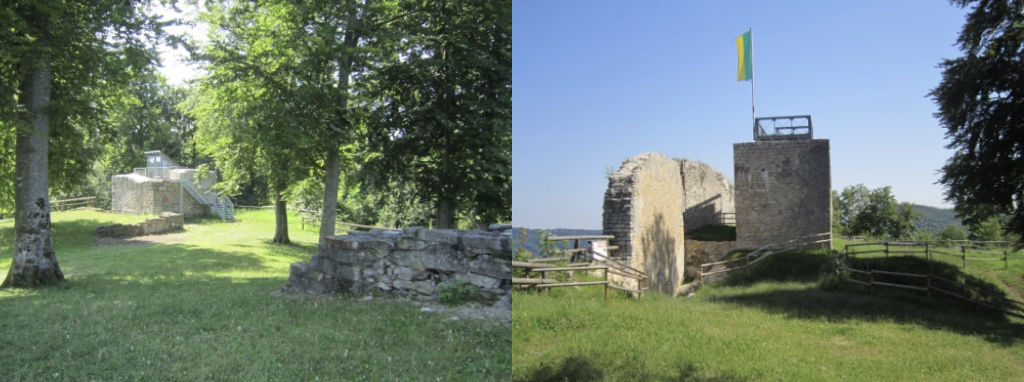
Castle keep | © M. Weidenbacher
Object details:
Object: The two castle keeps (Bergfriede) of the Hiltenburg near Bad Ditzenbach, today used as observation tower and exhibition room.
Location: County of Göppingen
Hunting
The painting in the Codex Manesse shows nobles during their boar hunt. The noble on his horse and his companion are using their swords to slay the animal which was cornered by two dogs. A further huntsman fled the boar and found shelter on a tree.
Hunting was an important component of noble self-confidence and of court life in medieval Germany. The hunt did not only provide meat, but was also used to represent lordly power and proof the own performance abilities. Due to the keeping of horses and dogs, hunting was expensive. Therefore, the distinction between high and low hunt was made. In the high hunt, black and red game were hunted, while the low hunt focused on small animals such as rabbits and foxes.
![Herr Heinrich Hetzbold von Weißensee | © Universitätsbibliothek Heidelberg, Cod. Pal. germ. 848, Bl. 228r [https://digi.ub.uni-heidelberg.de/diglit/cpg848/0451] - CC-BY-SA-3.0 © Universitätsbibliothek Heidelberg, Herr Heinrich Hetzbold von Weißensee, Cod. Pal. germ. 848, Bl. 228r [https://digi.ub.uni-heidelberg.de/diglit/cpg848/0451] - CC-BY-SA-3.0](https://museum-ressourcenkulturen.de/wp-content/uploads/2019/02/6_Jagd.jpeg)
Herr Heinrich Hetzbold von Weißensee | © Universitätsbibliothek Heidelberg, Cod. Pal. germ. 848, Bl. 228r [https://digi.ub.uni-heidelberg.de/diglit/cpg848/0451] - CC-BY-SA-3.0
Object details:
Object: Visualization of hunting scene within the Codex Manesse
Location: Library of the University of Heidelberg
Material: Topcoat on parchment
Size: 25 cm wide, 35 cm high
Dating to 1305-1340 CE
Symbols of Power in Bronze Age Syria
Scepter
Scepters as symbols of kingly power were not only used in Medieval Europe but also in the Ancient Near East. The displayed ivory scepter was found in Western Syria, in Qaṭna, where it was placed into the Royal Tomb between 1500 and 1300 BCE. Originally (around 3000 BCE), a scepter might have been seen as a kind of shepherd’s crook, which was used by the king, the good shepherd, to guide his subjects in godly reign.
The displayed scepter was constructed of three ivory pieces of a hippopotamus’ tusk. The crowning of the scepter seems to imitate the papyrus-like capitals of Egyptian columns, which reflects the many contacts between Egypt and Syria during the second millennium BCE. The indentation at the end of the scepter suggests that originally there might have been a now missing piece present in the scepter. This could have been a gemstone or a precious metal inlay.

Scepter | © P. Frankenstein u. H. Zwietasch, Landesmuseum Württemberg, Stuttgart
Object details:
Object: Sceptre
Find location: The Royal Tomb in Qaṭna, Syria
Location today: National Museum of Damaskus
Material: ivory (hippopotamus)
Size: 33 cm long
Dating to c. 1500-1300 BCE (Late Bronze Age)
The scepter was found in the Royal Tomb of Qaṭna, where it lay - together with human remains and vessels of fired clay - in the stone sarcophagus. It was put there as a gift to the deceased member of the local dynasty. The picture shows the position of the light gray sarcophagus in the central tomb of the Royal Tomb. It also contained stone benches with crockery from the ritual funeral banquet and prestigious stone vessels and ornamental objects.
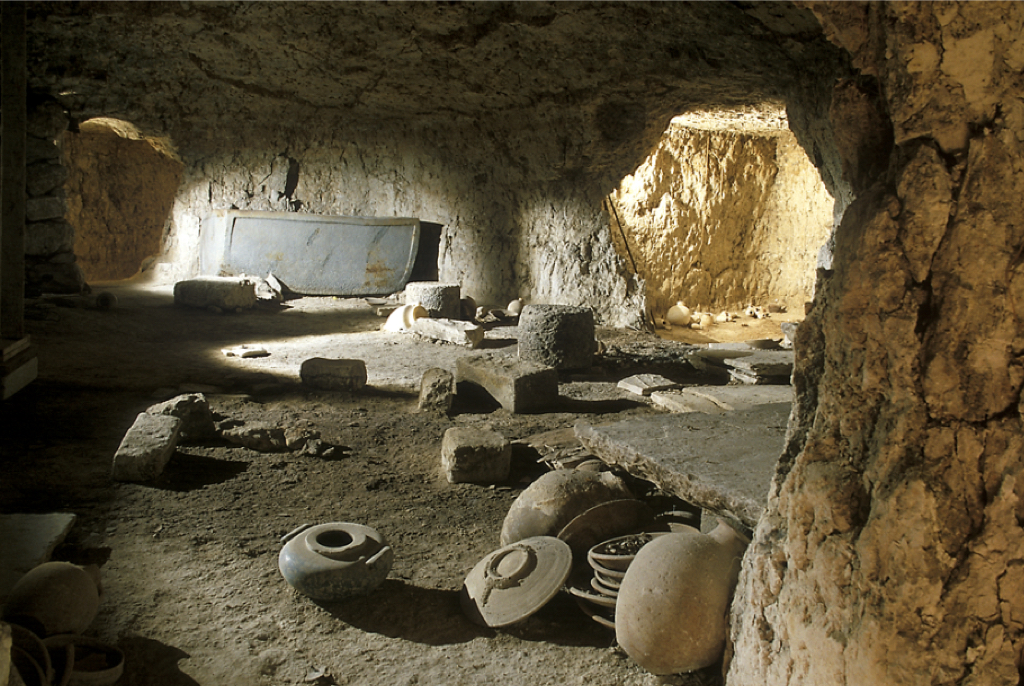
Crypt | © K. Wita, Qaṭna-Projekt, Universität Tübingen
King Statues
The two approximately 85 cm high statues represent the ideal appearance of an Old Syrian king. The hem of the Syrian mantle with rolled borders (the so-called Syrian “Wulstmantel”) surrounding the shoulders and a raised coiffure fixed by a ribbon are visible. A well-groomed beard surrounds the cheeks and chin. This type of depiction was reserved exclusively for kings and gods. The two figures made of basalt, a grey and extremely hard volcanic rock, were originally located to the left and right of the entrance to the royal tomb of Qaṭna. The rulers of stone stood enthroned in front of the tomb until a fire destroyed the palace and buried it under tons of stone and clay brick rubble.
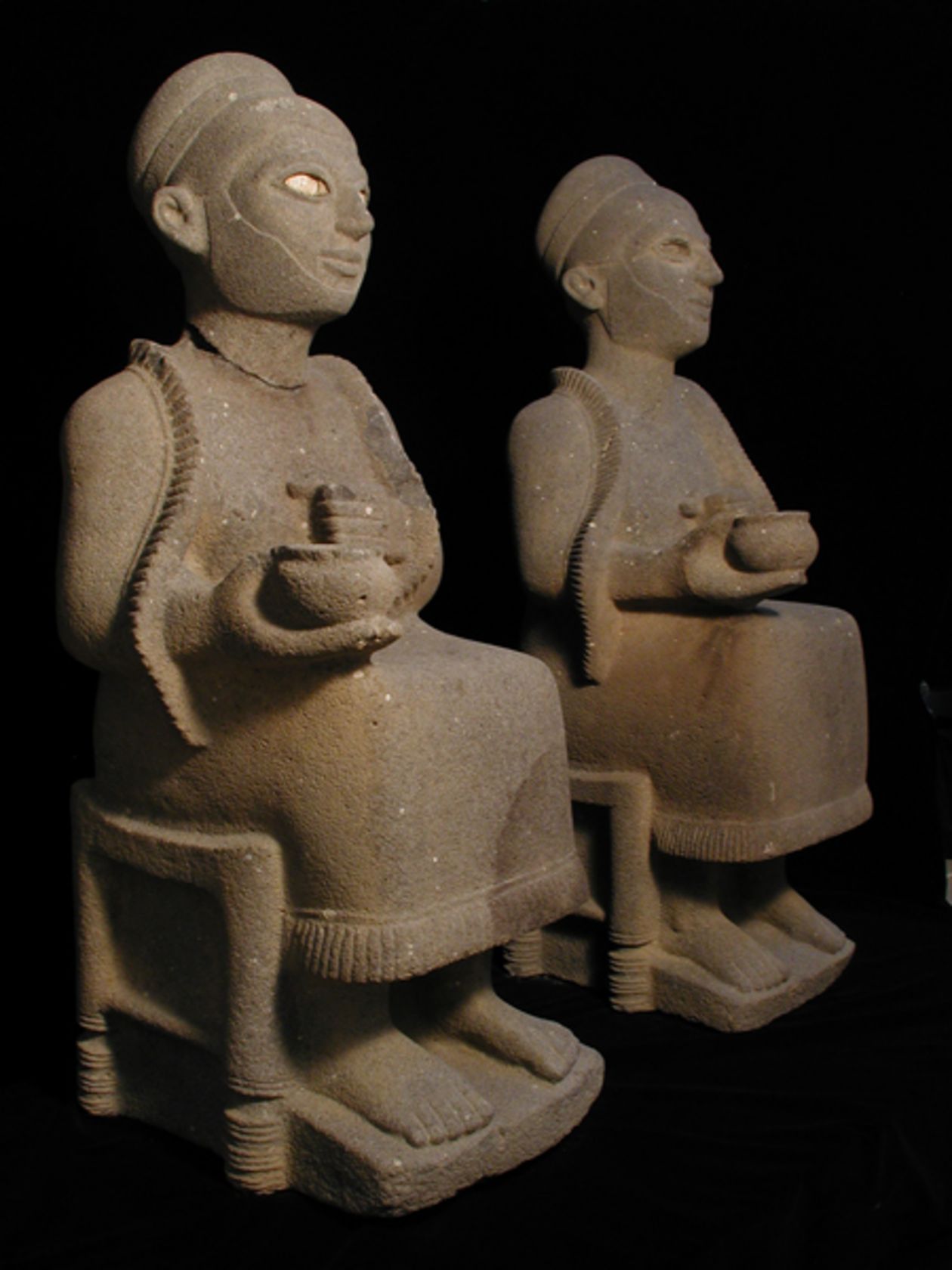
King statues | © K. Wita, Qaṭna-Projekt, Universität Tübingen
Object details:
Object: 2 statues of kings
Find location: Qaṭna Syria at the entrance to the Royal Tomb
Location today: National Museum of Damascus
Material: Basalt
Maße: ca. 85 cm high
Dating to the Middle Bronze Age, ca 1800 BCE (time of production)
From today’s perspective, the fire was a stroke of luck. Through this sudden catastrophe, the arrangement of the statues and the different clay vessels and food scraps placed in front of the statues were preserved. The head of the left statue was discovered in the vicinity of bowls containing food remains. Contemporary sources explain that the food was an offering to the deceased kings. These offerings were for family and religious reasons, but they were also important means of legitimation. By paying homage to his faded predecessors, the incumbent king symbolically placed himself in the long line of an (allegedly) unbroken sequence of venerable ancestors. The high age of the two basalt statues, they had been made some centuries before their last worship around 1340 BC, might have been beneficial to this idea of legitimacy.
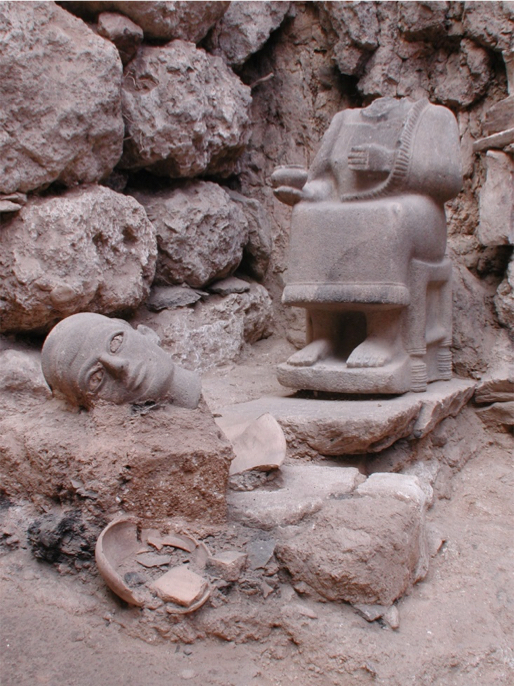
Damaged king statue | © K. Wita, Qaṭna-Projekt, Universität Tübingen
Duck Heads
Power can be presented in various forms, although size is not always important. The golden ornament in the shape of two duck heads measures only approximately 7 cm. It still conveys a clear message of political and economic power, as the precious metal gold was used, which was already very expensive at the time. Further, the face of the Egyptian mother goddess Hathor between the duck heads refers to trade contacts with the powerful neighbour Egypt. The impressive details of the piece, such as the naturalistic execution of the duck beaks and feathers bear witness to the precision craftsmanship. Such crafts could not be afforded by anyone, with the exception of the kings of the Late Bronze Age.
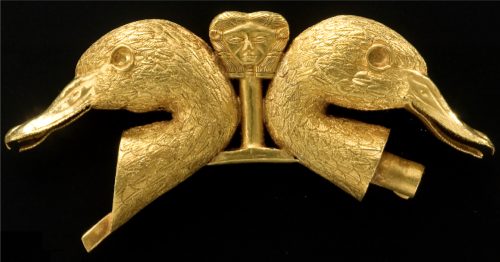
Duck heads | © P. Frankenstein u. H. Zwietasch, Landesmuseum Württemberg, Stuttgart
Object details:
Object: handle (?) in form of two duck heads, the head of Hathor displayed in between
Find location: Royal Tomb of Qaṭna, Syria
Location today: National Museum of Damascus
Material: Gold
Size: max. 7 cm long
Dating to the Late Bronze Age (1500-1400 BCE)
As there are no parallels to the golden duck heads in Ancient Near Eastern archaeological finds, there are only hypotheses concerning their function. Make-up vessels from Syria and Egypt with duck heads are known, but were usually made of ivory and other materials and only had one duck head, not two. It is, however, plausible that the golden duck heads were part of a bigger object and probably acted as a handle or decoration. Indication for the handle function are the pins at the neck of the duck. These could be placed into indentations within the object to fasten the handle. The eyes of the ducks probably contained gemstones, which are now lost.
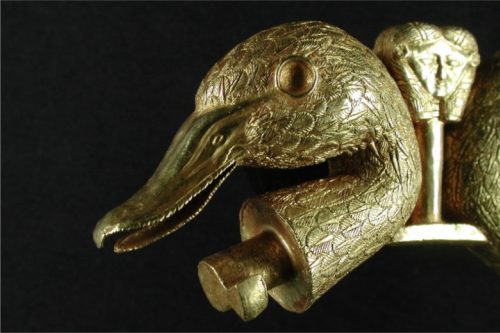
Close up of the duck heads | © K. Wita, Qaṭna-Projekt, Universität Tübingen
Symbols of Power in Northern Europe
Fortification
Hedeby – Schleisiedlung, trading center and place of power. The favorable location between North Sea and the Baltic in present-day Schleswig-Holstein made Hedeby one of the wealthiest early medieval settlements of Northern Europe.
Hedeby´s wealth was based on traders, who wanted to avoid the dangerous sail around the Cimbrian Peninsula. Instead, they chose the route via the river Schlei, which led 40 km into the inland and directly to the harbor and trading area.
Control over this important trading route – and thereby Hedeby itself – offered enormous economic power. Another aspect relevant to Hedeby´s significance was its location close to the border between Danish and Franconian Empire. It, thus, was strategically important for military operations.
In the second half of the 10th century, this encouraged Danish king Harald Blauzahn to have the semicircular wall around the settlement erected. The elaborate wall complex is witness to the former meaning of Hedeby as it still structures the landscape today.
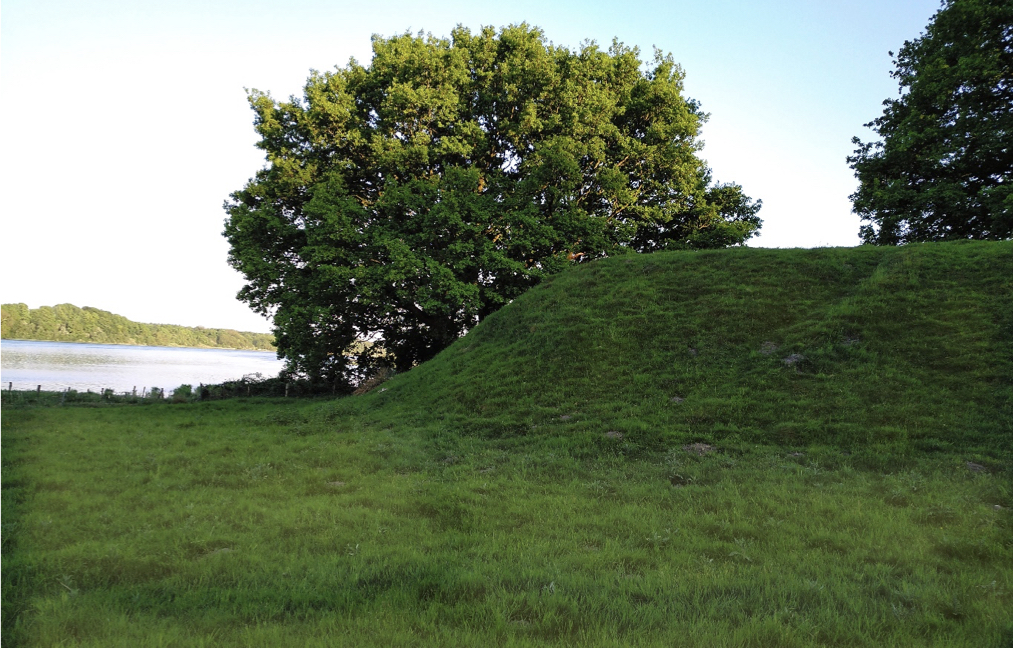
Wall | © V. Palmowski
Object details:
Object: Semicircular wall of Hedeby, with a view of the Haddebyer Noor
Location: Hedeby, ca. 6 km South of Schleswig
Material: Earth wall construction
Size: 4-5 m high, 5-10 m wide, 1.3 km long, enclosing an area of 24 ha
Dating: 950-1000 CE